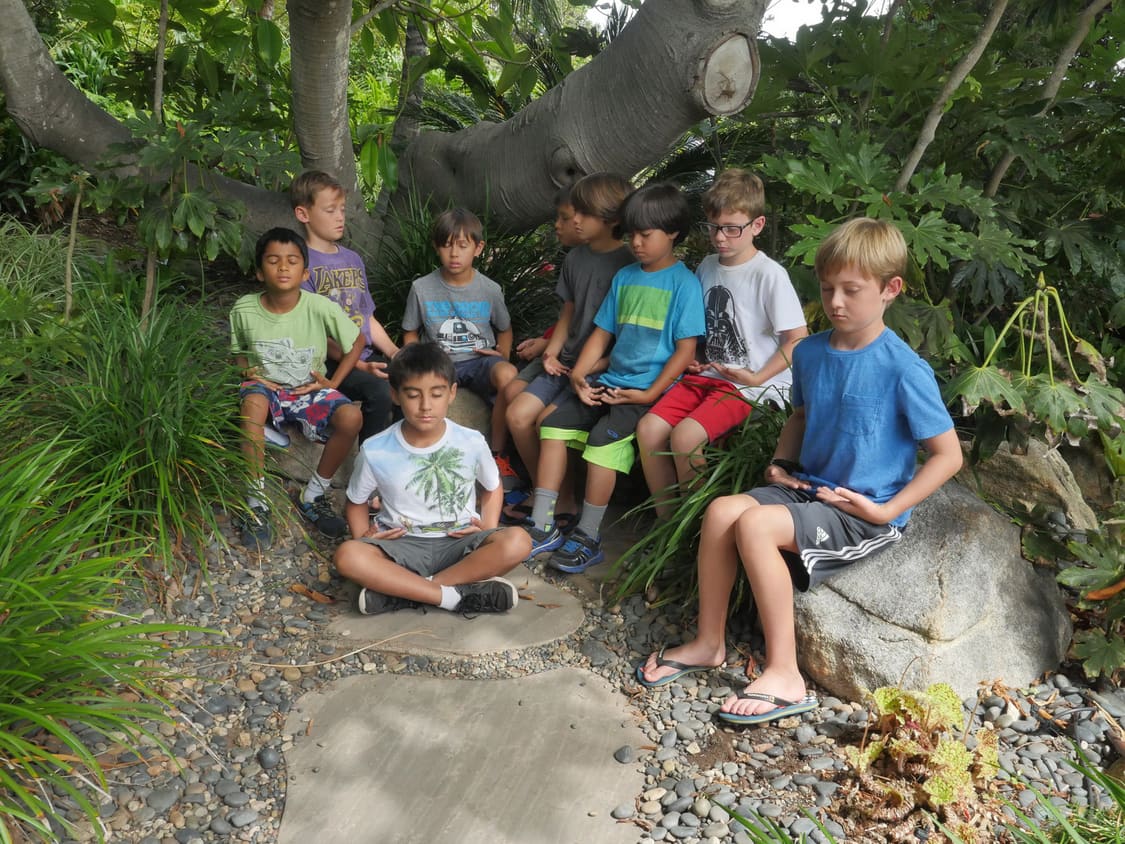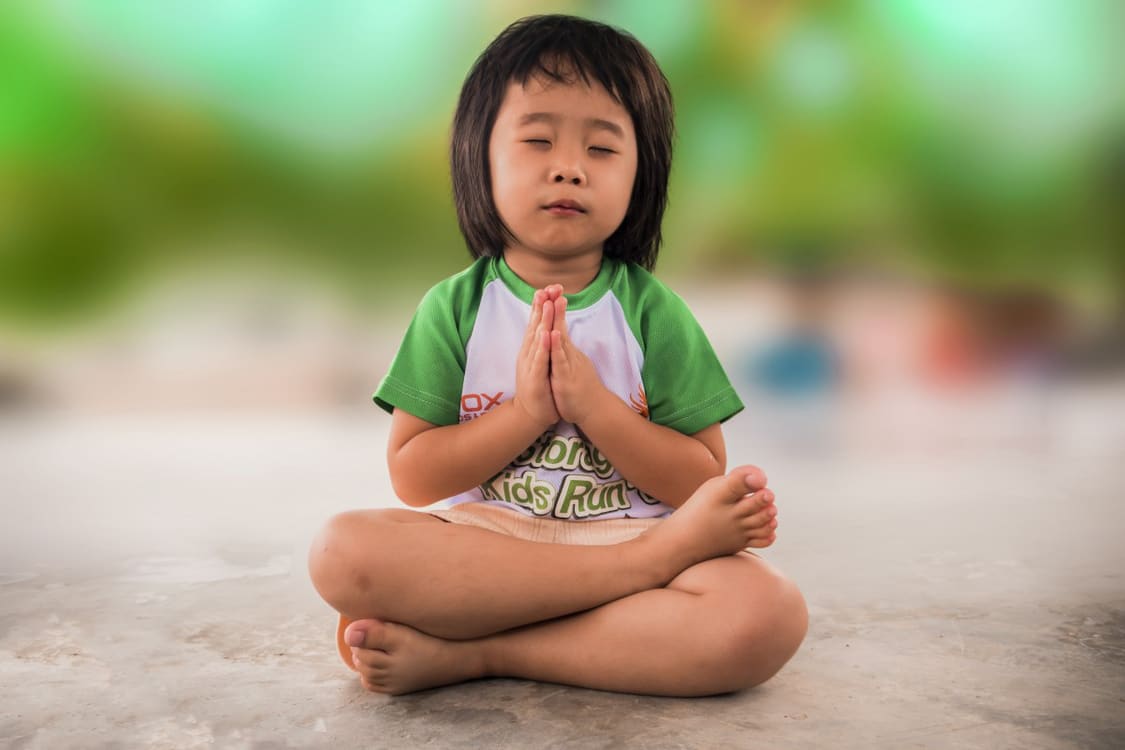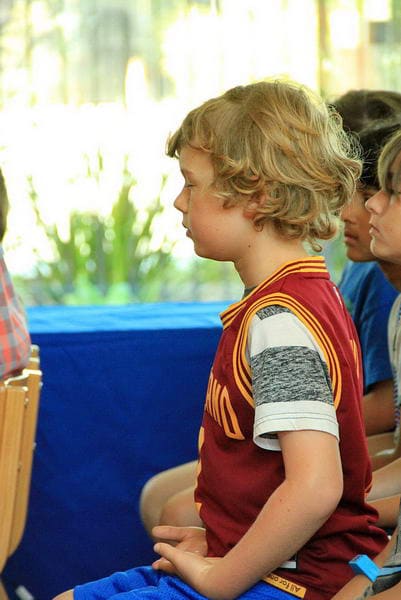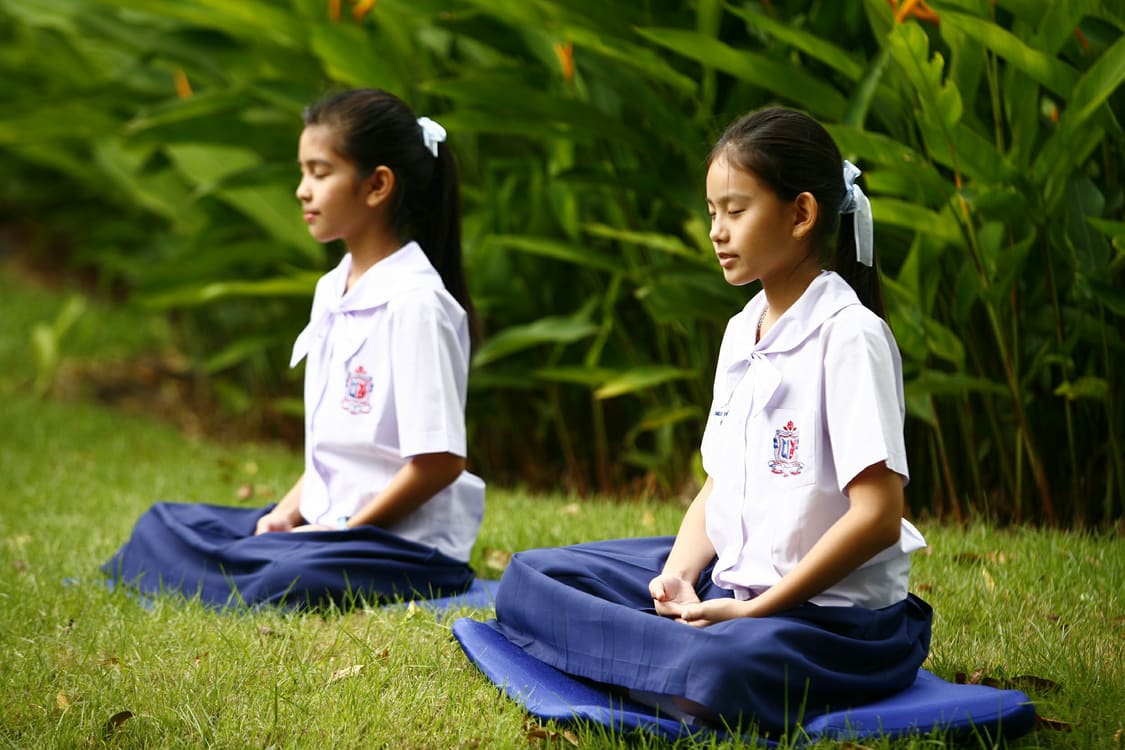Meditating with Children – SRF YSS magazine
This detailed article on teaching meditation to children was published in SRF magazine in 2006 and in YSS magazine in 2007. It is written by an Educational Psychologist, named Patricia Evertz, who has served in SRF YSS Sunday School programs for more than 30 years.
In this extremely useful article, she gives great guidance on the topic, making it a must read for all parents. Self-Realization Fellowship has released this article online in a magazine like muti-column format in a PDF file. This PDF is difficult to read, especially on a mobile device, so I am re-sharing the same article again in an easy to read format.
Note: The images below were not present in the original article. They have been added to make the post visually appealing.
Meditating with Children - Patricia Evertz

“Meditation is when you sit real still and let God fill up your heart with love,” explains five year old Heather. She demonstrates: With feet flat on the floor, she holds her back erect in her preschool-size chair, and puts her palms on her lap facing “up toward the sky.” She closes her eyes, and gently lifts her gaze to the point between the eyebrows. Her meditations may be brief—only a couple of minutes—but little Heather nonetheless understands some of the basics.
Across the hall in another Sunday school room of the Self- Realization Fellowship Temple in Pasadena, a group of ten-to- twelve-year-old boys are having a longer meditation of about ten minutes. Afterwards they consider challenges that confront adult and children meditators alike. “What are some things that disturb your meditation?” their teacher asks. The boys share: noises from the neighboring classes, emotions, thoughts, being hungry or thirsty. “What can you do when these things distract you?”
“Look into the spiritual eye and ask God to help you.”
“Watch your breath go in and out.”
“Mentally repeat the chant we just sang.”
According to Time magazine, ten million Americans practice some form of meditation on a regular basis. Now it appears that kids are starting to follow their parents’ example. The Los Angeles Times recently cited a report saying that dozens of in-school meditation programs are springing up across the country with many more programs for children offered in after-school clubs, religious and meditation centers, and through independent organizations.
“Not a day goes by that I don’t get a request from somebody wanting to teach meditation to children or study its effects,” says Susan Kaiser Greenland, founder and executive director of the nonprofit Inner Kids Foundation in Los Angeles. Three thousand miles away at Conte West Hills, a magnet school for inner-city kids in New Haven, Conn., guidance counsellor Linda Baker says attendance has skyrocketed in her after-school relaxation program, which guides kids through meditation, yoga, and related activities.
“In the beginning, we had five kids, now we have waiting lists,” said Baker, who started the program five years ago.
In this restless age of ubiquitous TV sets and video games, an increasing number of children are choosing to sit quietly and explore their inner peace. One young camper wrote about her experience in the SRF Summer Youth Program, “When I was meditating it was so peaceful. It felt like God was giving me a big hug.”
What is the most effective way to introduce children to meditation? How can we present meditation in a way that is simple and appealing to them? For more than nine decades, beginning with Paramahansa Yogananda’s school for boys at Ranchi, Self-Realization Fellowship has taught meditation to young people. Here are a few tips from SRF Sunday school teachers, Youth Program staff, and parents who meditate with their children.
Keep it simple
Paramahansa Yogananda often commented that God is as close to you as your thought allows Him to be. A sincere prayer and a few moments of silence can be all that is needed to bring God into a child’s life. Prayers do not need to be long or sophisticated. A heartfelt prayer like, “Come to me,” or “Fill me with Your love,” can be enough to draw God’s response. Children do not need to understand the entire science of yoga to meditate effectively. Simple techniques such as visualization exercises or singing a chant with deeper and deeper attention, can work very effectively for them.

Begin where they are
Consider what motivates your child. What does he or she naturally respond to? What uplifts your child? Use that as a springboard to draw God into his or her life. For instance, if your daughter has a special friend at school she is very close to, you can point out that her feelings for her friend are a little bit of God’s love. In meditation have her focus on her feelings for her friend and then have her try to feel that same love for God. You can also practice a visualization exercise with her to expand her love, beginning with feeling and sending love to her friends and family, then neighbors and city, and finally to all in the world.
If your child is into sports, explain how focusing attention at the point between the eyebrows develops will power. Help children understand how meditation will help them in their daily lives.
Make it fun
Present meditation to children in a way that appeals to their natural sense of playfulness. Once children learn the proper meditation posture, here is a way to test their understanding: Sit with your spine bent, legs crossed, and swing your foot, closing your eyes so tightly that you are squinting. Then ask, “Am I ready to meditate?”
Most children will love correcting you!
“No, you have to sit with your back straight, like this!”
“Hold still.”
“Put your feet flat on the floor.”
“Close your eyes gently—not so tight!”
Then respond, “There are so many things to remember! Can you do that all at once? Really? Show me.”

If your children squirm during meditations, before meditation you might play a different game. Ask them to sit in meditation posture, and explain that you are going to tickle them under their chins with a feather or silk scarf. See if they can continue to hold the correct meditation posture while they are doing this. Then let them test you! Afterwards, have a short meditation, challenging everyone (yourself included) to sit just as still as they did during the game. Short exercises like these introduce fundamentals in an enjoyable way.
Use language and techniques that are age-appropriate
Use language that your children understand, and explain terms they don’t know. Suppose you begin your meditation with one of Paramahansa Yogananda’s chants, “Listen, Listen, Listen.” (The words to this chant are, “Listen, listen, listen to my heart’s song. I will never forget Thee; I will never forsake Thee.”) Explain what “forsake” means. Ask very young children, “Who is meant when we say ‘Thee’?” Have them put in their own words what the chant means. Then chant together from your hearts, first in a voice of normal intonation, then softer and more softly until chanting mentally, “whispering the words in our hearts where only God can hear us.” (You need not know how to play the harmonium to chant with your children. Try chanting a capella, or use a tape of SRF monks or nuns chanting.) Likewise, if you lead your children in an affirmation, check their understanding before they practice. For instance, if you use the affirmation, “I am safe in the fortress of Thy presence,” make sure your children understand the meaning of “fortress.” Point out how strong and powerful a fortress is, and how God’s protection, though invisible, is actually stronger than any fortress. Then repeat the affirmation as you would the chant, first in normal intonation, then softer and softer until you are mentally chanting it together. For teens, there are several meditations in Metaphysical Meditations you can use verbatim, but discuss words like “myriad,” “all-pervading,” and “emancipation” that appear in some of the passages.
Visualization exercises, chanting, affirmations, and the Healing Technique (given in the SRF Worldwide Prayer Circle booklet), can all be practiced effectively by children.
Empathize with their struggles
Meditation is a struggle for all of us at times. When our minds are restless it can be a challenge to sit still and focus one-pointedly on God. Here is how one Sunday school teacher approached this subject with her students:
“When leading a meditation with some younger girls (six to eight years old), I used a bottle of oil with glitter suspended in it to illustrate our restless thoughts. Shaking up the bottle before the meditation, I explained, ‘This glitter shows how our thoughts are— often restless, whirling around inside of us. If I set this bottle down and allow it to be still, the glitter settles to the bottom. When we meditate, our thoughts come to rest, and we feel more peaceful and still. I am going to set this bottle down, and we’ll meditate. We’ll see if our thoughts settle down during our meditation, and we’ll see how the bottle looks afterwards.’ After the meditation, I checked with the class, ‘How was your meditation? Did your thoughts settle down, like the glitter in the bottle?’ One girl explained, ‘No, my thoughts were still like this!’ and shook the bottle hard so the glitter whirled around. It was a good springboard for discussion. We all agreed that we, too, have had meditations that seemed like that. I pointed out that sometimes we may not feel God’s peace during meditation, but God blesses us in some other way. Maybe some problem we were having is solved, or God removes some difficulty. It was a great opportunity to discuss how we all at times struggle with the mind in meditation, and to point out that, no matter how restless we are, no effort is without reward.”
Encourage, but don’t push
Sri Daya Mata has said, “It is a mistake to try to force any child into a particular spiritual mould. First he has to have a desire for and an interest in things spiritual. This inclination will be there if from a very early age he is encouraged in cultivating spiritual attitudes: love for God, faith in God, a feeling of companionship with Him.”
Expose your children to meditation, and see how they respond. Some may enjoy it and perhaps do it often; others may not be ready. Bear in mind that if they don’t show an interest in meditation at this time, they may in the future. They will be more receptive later on if they are not forced to meditate before they are ready.
Think of the example of flowers. Each one unfolds at a different time, yet each one is beautiful. Trying to force open a bud that is not ready will only destroy the flower. Allowing blossoms to open at their own time produces the loveliest flowers. Late bloomers are just as beautiful as early bloomers, so there is no need to push.

If your children don’t want to do it on a daily basis, see if they are interested in having a weekly family meditation. Keep meditations short, and involve the children, allowing them to participate in leading the prayers or playing simple instruments for a family kirtan. If even this seems too much, just quietly set the example. “My children meditate regularly at Sunday school,” commented one mother, “but they don’t seem interested at home. However, they like to see me meditating. Often they ask me to meditate in their room at night after I tuck them in. They want me to say my prayers out loud, and then they fall asleep while I am meditating. It doesn’t always work in my schedule, but I do it whenever I can.”
Keep meditations brief
In the SRF Sunday school program we have generally found the following lengths work best for children’s attention spans:
Ages 3–5 ——> 1-3 minutes
Ages 6–8 ——> 3-5 minutes
Ages 9-12 ——> 5 minutes to start with, gradually increasing to 10-15 minutes as they gain experience.
Ages 13-15 ——> 5-10 minutes to start with, gradually increasing to 20 minutes or longer as they gain experience.
The meditations are not only periods of silence. They include prayers and talking the child through the meditation, including such elements as a chant, affirmation, or visualization, or praying for others. The actual periods of silence should depend on the age group, for example, 5–15 seconds of silence at a time for preschoolers. “If I hear a big sigh at the end of meditation,” comments one teacher, “then I know I’ve pushed the kids too long.” As in show business, it is best to leave them wanting more!

Provide opportunities to meditate with other children
If you have children who seem open to meditation, try providing opportunities to meditate with others their age, if possible. Attending a weekly Sunday school class at an SRF temple or center can do much to reinforce their efforts. Many children ten and older find support in the SRF Summer Youth Program. One boy commented, “I want to come back because it felt so spiritual meditating with a whole group. The thing I enjoyed the most was chanting. I really put my heart into the chanting and it filled me up with joy.”

Accept spiritual development as a gradual process
Keep in mind that change is a gradual process and may not always be apparent. Children as well as adults will have their ups and downs. Be supportive and encouraging, especially during their difficult times, and don’t be discouraged if there are times when they stray from their spiritual habits. These periods can be valuable learning opportunities for the child. An older Youth Program camper, who attended regularly for years, described her last camp experience this way: “Before I came to camp, my life felt very disorganized and hectic. After being at camp this week, I realized it was because I had lost sight of my inner peace and calmness. By exploring deep divine peace through meditation, I feel I have regained this foundation and as a result will be able to take it home with me.”